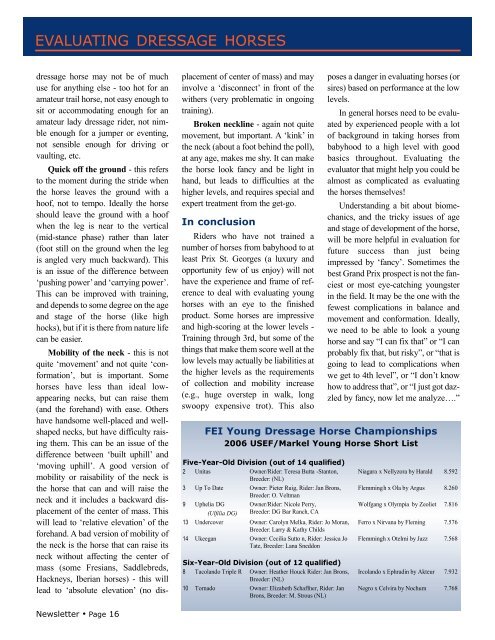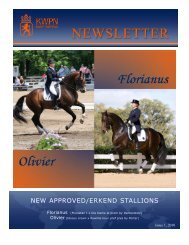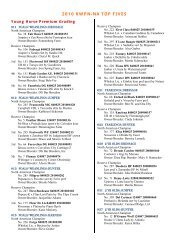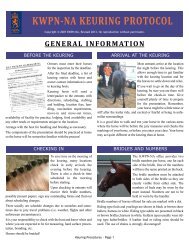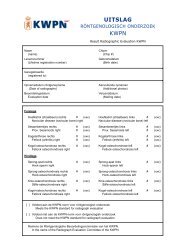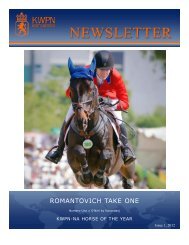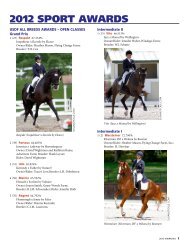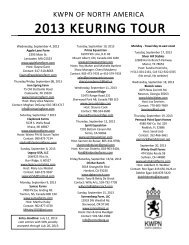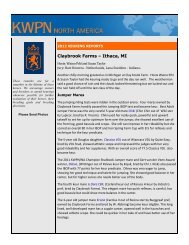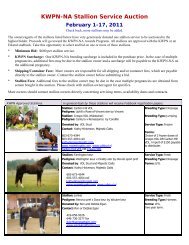Download PDF - KWPN
Download PDF - KWPN
Download PDF - KWPN
Create successful ePaper yourself
Turn your PDF publications into a flip-book with our unique Google optimized e-Paper software.
EVALUATING DRESSAGE HORSES<br />
dressage horse may not be of much<br />
use for anything else - too hot for an<br />
amateur trail horse, not easy enough to<br />
sit or accommodating enough for an<br />
amateur lady dressage rider, not nimble<br />
enough for a jumper or eventing,<br />
not sensible enough for driving or<br />
vaulting, etc.<br />
Quick off the ground - this refers<br />
to the moment during the stride when<br />
the horse leaves the ground with a<br />
hoof, not to tempo. Ideally the horse<br />
should leave the ground with a hoof<br />
when the leg is near to the vertical<br />
(mid-stance phase) rather than later<br />
(foot still on the ground when the leg<br />
is angled very much backward). This<br />
is an issue of the difference between<br />
‘pushing power’ and ‘carrying power’.<br />
This can be improved with training,<br />
and depends to some degree on the age<br />
and stage of the horse (like high<br />
hocks), but if it is there from nature life<br />
can be easier.<br />
Mobility of the neck - this is not<br />
quite ‘movement’ and not quite ‘conformation’,<br />
but is important. Some<br />
horses have less than ideal lowappearing<br />
necks, but can raise them<br />
(and the forehand) with ease. Others<br />
have handsome well-placed and wellshaped<br />
necks, but have difficulty raising<br />
them. This can be an issue of the<br />
difference between ‘built uphill’ and<br />
‘moving uphill’. A good version of<br />
mobility or raisability of the neck is<br />
the horse that can and will raise the<br />
neck and it includes a backward displacement<br />
of the center of mass. This<br />
will lead to ‘relative elevation’ of the<br />
forehand. A bad version of mobility of<br />
the neck is the horse that can raise its<br />
neck without affecting the center of<br />
mass (some Fresians, Saddlebreds,<br />
Hackneys, Iberian horses) - this will<br />
lead to ‘absolute elevation’ (no displacement<br />
of center of mass) and may<br />
involve a ‘disconnect’ in front of the<br />
withers (very problematic in ongoing<br />
training).<br />
Broken neckline - again not quite<br />
movement, but important. A ‘kink’ in<br />
the neck (about a foot behind the poll),<br />
at any age, makes me shy. It can make<br />
the horse look fancy and be light in<br />
hand, but leads to difficulties at the<br />
higher levels, and requires special and<br />
expert treatment from the get-go.<br />
In conclusion<br />
Riders who have not trained a<br />
number of horses from babyhood to at<br />
least Prix St. Georges (a luxury and<br />
opportunity few of us enjoy) will not<br />
have the experience and frame of reference<br />
to deal with evaluating young<br />
horses with an eye to the finished<br />
product. Some horses are impressive<br />
and high-scoring at the lower levels -<br />
Training through 3rd, but some of the<br />
things that make them score well at the<br />
low levels may actually be liabilities at<br />
the higher levels as the requirements<br />
of collection and mobility increase<br />
(e.g., huge overstep in walk, long<br />
swoopy expensive trot). This also<br />
Five-Year-Old Division (out of 14 qualified)<br />
2 Unitas Owner/Rider: Teresa Butta -Stanton,<br />
Breeder: (NL)<br />
3 Up To Date Owner: Pieter Ruig, Rider: Jan Brons,<br />
Breeder: O. Veltman<br />
poses a danger in evaluating horses (or<br />
sires) based on performance at the low<br />
levels.<br />
In general horses need to be evaluated<br />
by experienced people with a lot<br />
of background in taking horses from<br />
babyhood to a high level with good<br />
basics throughout. Evaluating the<br />
evaluator that might help you could be<br />
almost as complicated as evaluating<br />
the horses themselves!<br />
Understanding a bit about biomechanics,<br />
and the tricky issues of age<br />
and stage of development of the horse,<br />
will be more helpful in evaluation for<br />
future success than just being<br />
impressed by ‘fancy’. Sometimes the<br />
best Grand Prix prospect is not the fanciest<br />
or most eye-catching youngster<br />
in the field. It may be the one with the<br />
fewest complications in balance and<br />
movement and conformation. Ideally,<br />
we need to be able to look a young<br />
horse and say “I can fix that” or “I can<br />
probably fix that, but risky”, or “that is<br />
going to lead to complications when<br />
we get to 4th level”, or “I don’t know<br />
how to address that”, or “I just got dazzled<br />
by fancy, now let me analyze….”<br />
FEI Young Dressage Horse Championships<br />
2006 USEF/Markel Young Horse Short List<br />
9 Uphelia DG<br />
(Ulfilia DG)<br />
Owner/Rider: Nicole Perry,<br />
Breeder: DG Bar Ranch, CA<br />
13 Undercover Owner: Carolyn Melka, Rider: Jo Moran,<br />
Breeder: Larry & Kathy Childs<br />
14 Ukeegan Owner: Cecilia Sutto n, Rider: Jessica Jo<br />
Tate, Breeder: Lana Sneddon<br />
Six-Year-Old Division (out of 12 qualified)<br />
8 Tacolando Triple R Owner: Heather Houck Rider: Jan Brons,<br />
Breeder: (NL)<br />
10 Tornado Owner: Elizabeth Schaffner, Rider: Jan<br />
Brons, Breeder: M. Strous (NL)<br />
Niagara x Nellyzora by Harald 8.592<br />
Flemmingh x Ola by Argus 8.260<br />
Wolfgang x Olympia by Zeoliet 7.816<br />
Ferro x Nirvana by Fleming 7.576<br />
Flemmingh x Otelmi by Jazz 7.568<br />
Ircolando x Ephradin by Akteur 7.932<br />
Negro x Celvira by Nochum 7.768<br />
Newsletter • Page 16


